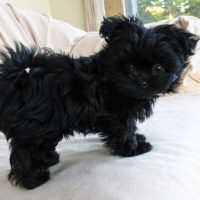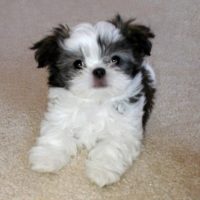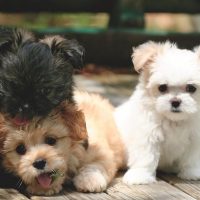The Miki Dog rare breed of small toy dogs that have been developed during the 1980s, using different breeds introduced in North America.
What is a Miki Dog?
The sociable and sweet-natured little Mi-Ki dog breed is an up-and-coming companion toy dog. It’s a small-sized dog which weighs some 4 and 10 pounds. The Mi-Ki is cat-like in agility but all dogs when it comes to loyalty and friendliness.
Renowned for his gentle nature, the Mi-Ki is calm, adaptable, and delightfully Gremlin-like (remember Hollywood’s 1984 movie Gremlins?) in appearance.
Appearance
Its apple domed head features large dark eyes, and a short, wide muzzle, with a black nose. These dogs have large dark eyes and a characteristic stop. The mini Miki dog has erect feather ears that are quite movable.
The body of the dog is somewhat elongated with a straight, leveled backline, that stands upon four hare-like feet. With their little size and gentle nature, Mikis usually make great condo or apartment dogs.
History
Miki though a recent breed but it a rare one, and the history of this breed is in ambiguity and is still debated. There are different theories to the origin of Miki dogs.
According to the Mi-Ki Club of America, Inc., the Mi-Ki is thought to be Asian. It is debated that it shares common ancestors with the Papillon, the Maltese, and the Japanese Chin.
Unfortunately, the bleak details of the Mi-Ki make it impossible to tell the percentage of each parent breed in its makeup.
In 1992, testing revealed a specific DNA profile, naming the Mi-Ki, a purebred dog. The Mi-Ki was recognized by the States Kennel Club in 1995.
Some theories also suggest that other breeds like the Yorkshire Terrier, Pomeranian, Pekingese, and Shih Tzu may have been used. But, no one knows if this is true.
Miki Dog Pictures
Quick Information – Miki Dogs
| Characteristics | Details |
|---|---|
| Name | Miki |
| Other Names | Mi-ki, Mi Ki |
| Color | Brown, Black, White, Tan, Black and Tan, Tricolor |
| Coat | 2 Types Smooth Coat Long Coat |
| Breed Type | Crossbreed |
| Breed Group | Toy Dog, Companion Dog, Therapy Dog, Watch Dog |
| Size | Small Sized |
| Hieght | 10-12 inches |
| Weight | 5-10 Pounds |
| Life Span/Life Expentancy | 12-14 Years |
| Temperament | Affectionate, intelligent, alert, playful, protective, social |
| Shedding | Minimal |
| Hypoallergenic | Yes |
| Barking Level | Rare |
| Energy Level | Active |
| Good with Children | Yes |
| Good with Other Dogs | Yes |
| Litter Size | 1-5 Puppies |
| Country of Origin | USA |
| Competitive Registration/Qualification Information | MCOA, IMR, MBUSA, CMA, R Inc., APRI, DRA |
Temperament and Behavior
The most amazing trait of the Miki dog is their adaptability, to people and situations. These dogs are obeying, extremely affectionate, as also alert at the same time. Thus, they are well-suited pet for the elderly and disabled people since they make good therapy dogs and companion dogs.
Though they are alert, they are also calm and quiet at times, and rarely bark for no reason, but mostly, if only feel threatened. They have a high degree of intelligence that would easily excel in the obedience ring.
This dog is a quick learner who would grow up to a good service dog. Like cats, they are social by nature with an even temperament, as they also love children, spending playful moments with them, prancing upon toys and play objects.
The Mikis are even comfortable with other pets, including cats. They are non-aggressive, but rather friendly with strangers, and would get along well with them.
Care – Exercise
Given their size and enthusiastic personality a Miki dog needs a daily walk. Take it out regularly, especially to help release its energy. They are active by nature and would play all day in a small house or apartment (or even get used to their kennels). But, allowing them to play openly in an enclosed area, if available, is also good for their mental happiness.
Grooming
The low shedding Miki dog needs brushing at least once a week. This is to get rid of any possible dust particles they might catch in between their hairs while playing restlessly all day, as also to retain the usual smoothness.
The short muzzle of the Miki dog is prone to get them respiratory issues. So, do keep an eye. Also, weekly cleaning of their teeth is advisable for keeping them healthy. You can also shave their face and feet to help them stay clean, hygenic, and germ-free since they are prone to grow long hairs in between their toes.
Training
Training the intelligent Mi-Ki dog is rather easy, as they’re positive spirits and eager to please their masters. You should begin training your Miki puppy from 3-4 months of age. Teach the little one to come when it is asked to, or stay when it is told to. Give them lots of obedience and success rewards, and supply them with lots of encouragement.
Health Problems/Issues
Mi-Ki is a very healthy breed with no known breed-specific health issues. However, as mentioned, respiratory disorders might pester it at times. Also, do not ignore keeping an eye on other common dog diseases and problems.
Diet/Feeding
Dry food, over raw food, is better for the playful Miki dog since it needs almost a constant supply of glucose, especially the puppies.
Ready kibbles are a good supply of glucose since they might consume this at any point in time if supplied. Glucose deficiency often leads the puppy to ‘crash’.
Raw meat or canned food is certainly a good idea, though, since it is the ultimate source of energy for most canines and dog breeds in the longer run. However, do not consider the quantity of your Miki’s food with respect to the weight of your dog, but rather, on its daily level of exercise and activity. Also, remember that underweight or an obese Miki might easily bring in many health problems later.
Mi-Ki Puppies Images
Video: Miki Dog Playtime
Fun Facts about The Miki Dog
- The International Mi-Ki Registry considers Mikis with all four feet shaved
- Record says that a Mi-Ki dog has raised an entire litter of abandoned kittens.
- Although the Mi ki dogs often have a domed head, the International Mi-Ki Registry’s Mi-Ki heads are rounded, but not domed.
- Their eyes and the nose are large and mostly dark, although blue, brown, or ruby are also acceptable by the International Mi-Ki Registry, provided, the coats are of the same colors.
















